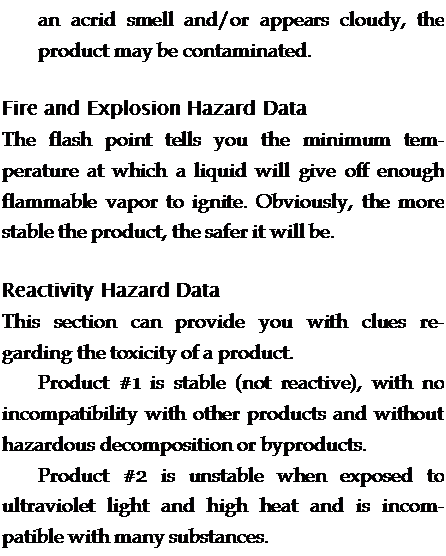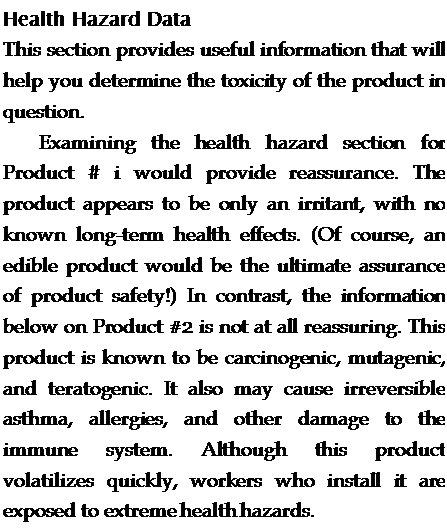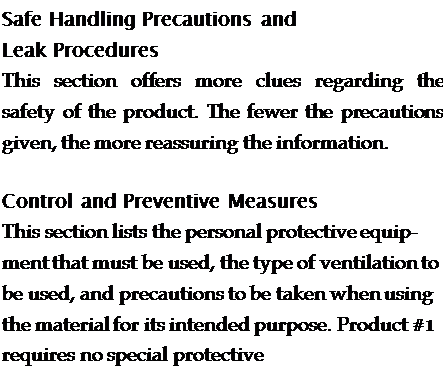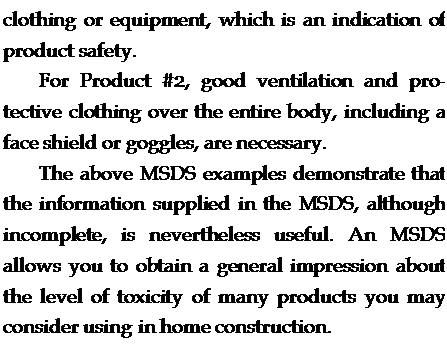Physical and Chemical Characteristics
This section describes how the material behaves. The information is useful for the design of ventilation systems and for providing adequate equipment and procedures for fire and spill containment.
• Vapor pressure tells you how much vapor the material may give off. A high vapor pressure indicates that a liquid will easily evaporate.
• Vapor density refers to the weight of the pure gaseous form of the material in relation to air. The weight of a given volume of a vapor (with no air present) is compared with the weight of an equal volume of air.
• Specific gravity tells you how heavy the material is compared to water and whether it will float or sink.
• Evaporation rate refers to the rate at which a material changes from a liquid or solid state to its gaseous form.
• Volatile organic compounds (VOCs) provide you with an idea of the degree to which the substance will outgas. If the material is toxic, the degree of volatility would be important to consider.
• Water reactivity indicates whether the chemical reacts with water to release a gas that is flammable or presents a health hazard.
• Appearance and odor indicate how a product is supposed to look and smell. For example, if the product is supposed to be clear and odorless but arrives onsite with
|
Section III — Physical Characteristics |
|||
|
Boiling Range: |
>369°F |
Vapor Pressure (mm Hg.): |
125mm Hg @ 100° F |
|
Specific Gravity (H20=1): |
1.1 -1.3 |
Vapor Density (Air = 1): |
> 1 |
|
% Volatile (Volume): |
< 1% |
Evaporation Rate (BuAc = 1): |
> 1 |
|
Volatile Organic Content (VOC): |
3.8 Ib./gal. |
||
|
Solubility (specify solvents): |
Miscible in water, alcohol, acetone, some glycol ethers; insoluble in petroleum hydrocarbons |
||
|
Appearance and Odor: |
Clear, odorless liquid |
NOTE: In the above M5DS, the evaporation rate is compared with the evaporation rate for butyl acetate. With this particular product, the evaporation rate is less than that for butyl acetate.
Product #2 TABLE 1.6
|
Section III — Physical/Chemical Characteristics |
||
|
Boiling Point: |
HCFC-22 |
-41.4° F at 1 ATM |
|
Polyurethane resin |
NE |
|
|
Vapor Pressure: |
HCFC-22 |
136 psia at 70° F |
|
Vapor Density (AIR = 1): |
HCFC-22 |
2.98 at 1 ATM |
|
Specific Gravity (H20=1): |
Polyurethane resin |
1.1 |
|
Solubility in Water: |
Insoluble, reacts with water |
|
|
Appearance and Odor: |
Gel under pressure. Faint ether-like odor. |
|
NOTE: Hydrochlorofluorocarbons, or HCFCs, are fluorinated carbons that are harmful to the ozone layer. |
|
Product # 1 TABLE 1.7
|
|
Section IV — Fire and Explosion Hazard Data |
|
|
Flash Point: |
Polyurethane Resin >400° F |
|
Extinguishing Media: |
Water fog, foam, C02, or dry chemical |
|
Fire Fighting Procedure: |
Wear self-contained breathing apparatus and turnout gear. Hazardous decomposition products include CO, C02, NO, and traces of HCI. Cured foam: Wear self – contained breathing apparatus. Hazardous decomposition products include CO, C02, NO, and traces of HCI. |
|
Usual Hazards: |
Temperatures above 120° F will increase the pressure in the can, which may lead to rupturing. Cured foam:This product will burn. Do not expose to heat, sparks, or open flame. This product is not intended for use in applications above 250° F (121° C). Always protect foam with approved facings. This product is not a FIRE STOP or FIRE BARRIER penetration sealant. |
|
Section V — Reactivity Data |
|
|
Stability: |
Stable under normal storage and handling conditions. Do not store above 120° F. Cured foam will deteriorate when exposed to UV light. |
|
Incompatibility: |
Water, alcohols, strong bases, finely powdered metal such as aluminum, magnesium, or zinc, and strong oxidizers. |
|
Conditions/Hazards to Avoid: |
Contamination with water may form C02. Avoid high heat, i. e., flames, extremely hot metal surfaces, heating elements, combustion engines, etc. Do not store in auto or direct sunlight. |


 |
 |
Product #1 TABLE 1.9
|
Section V — Health Hazard Data |
|
|
Route(s) of Entry: |
Eye contact, inhalation, ingestion |
|
Acute Health Effects: |
Eye contact: May cause redness or irritation |
|
Inhalation: |
N/A In sufficient doses may cause gastrointestinal irritation |
|
Skin contact: |
N/A |
|
Chronic Health Effects: |
Not listed as a carcinogen by the NTP, IARC, or OSHA; no adverse longterm effects are known. |
|
Medical Conditions Generally Aggravated by Exposure: |
No adverse long-term effects are known. |
|
Emergency & First Aid: |
Eye contact: Wash with clean water for at least 15 minutes. If irritation persists, get medical attention. |
|
Inhalation: |
N/A |
|
Ingestion: |
if irritation persists, get medical attention. |
|
Skin contact: |
N/A |
|
Product #2 TABLE 1.10
|
|
Section VI — Health Hazard Data
|

|
Section VII — Special Protection Data |
|
|
Respiratory Protection: |
None normally required |
|
Ventilation: |
None normally required |
|
Protective Gloves: |
None normally required |
|
Other Protective Clothing or Equipment: |
None normally required |
|
Section VIII — Storage and Handling Data |
|
|
Precautions to be taken in handling and usage: |
Store in original container; keep tightly closed. Do not reuse container for other purposes. KEEP OUT OF REACH OF CHILDREN. |
|
Other precautions: |
Read and observe all precautions on product label. |
Product # 2 TABLE 1.14
|
Section VIII — Personal Protection |
|
|
Respiratory protection: |
None required if in well-ventilated area. |
|
Clothing: |
Wear gloves, coveralls, long-sleeved shirt, and head covering to avoid skin contact. Contaminated equipment or clothing should be cleaned after each use or disposed of. |
|
Eye protection: |
Wear face shield, goggles, or safety glasses. |
|
Ventilation: |
If ventilation is not enough to maintain PEL, exhaust area. |
Household cleaning products are among the most toxic substances we encounter on a daily basis. It isironic that our efforts to clean up often produce further contamination by spreading noxious fumes throughout the house. Moreover, these products end up down the drain, where they pollute air, soil, and water.
Most commercial cleaning products are made from synthetic chemicals derived from crude oil. Labeling laws and the Trade Secrets Act make it difficult to know exactly what is in any particular product. The product may contain highly toxic substances, but consumers have no way of knowing. Some of the harmful ingredients found in commercial cleaning products include phenol, toluene, naphthalene, pentachlorophenol, xylene, trichloroethylene, formaldehyde, benzene, perchloreth – ylene, other petroleum distillates, chlorinated substances, ethanol, fluorescent brighteners, artificial dyes, detergents, aerosol propellants, and artificial fragrances.
Professional strength formulas, which are even more dangerous than household cleaning products, are often used when residential construction cleanup is contracted out to j ani – torial service providers.
Green Seal is an independent nonprofit organization that has created environmental






Leave a reply